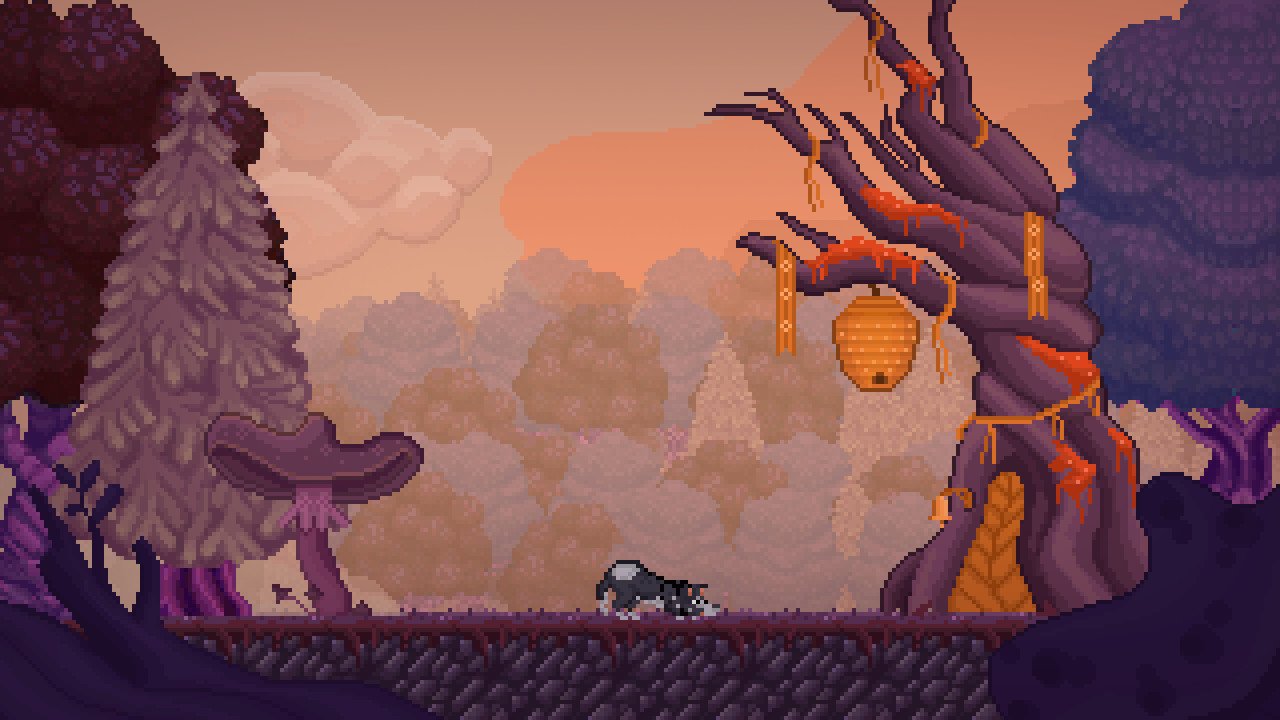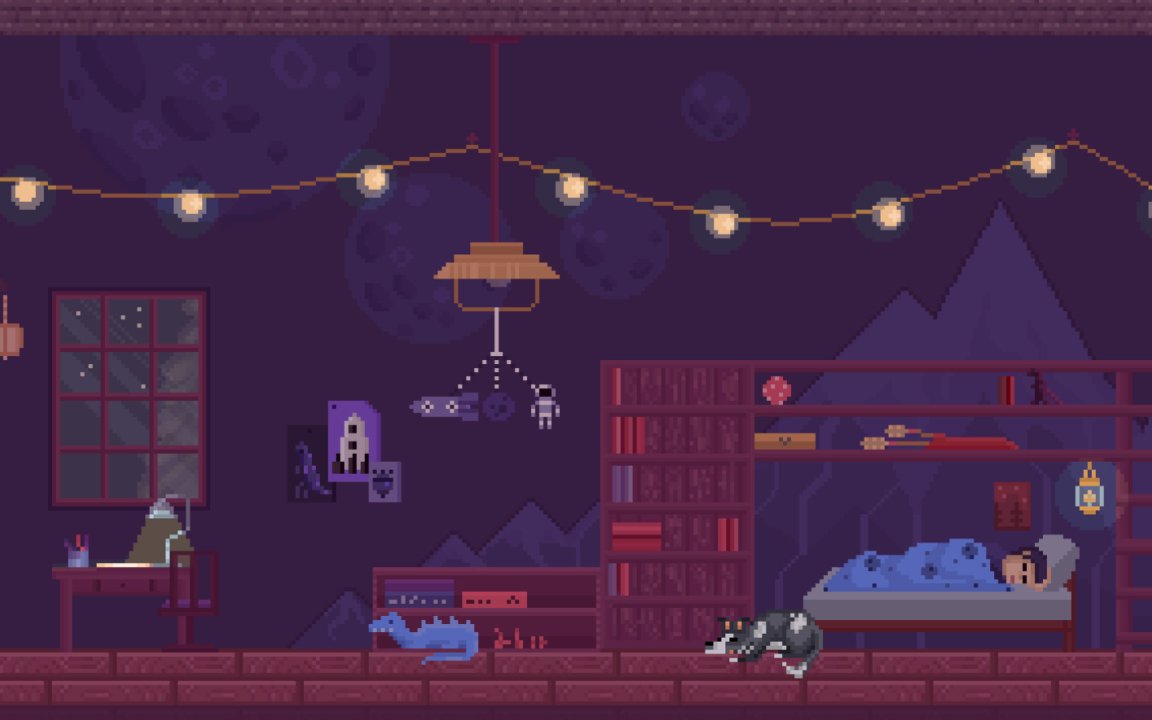Balthazar's Dream Review
Quaint in concept, but dogeared in practice
If you’ve ever had the pleasure of watching your dog caught in an impassioned gallop when snoozing on his side, chances are you’ve spent at least some time wondering what on earth is going on in there. For what it’s worth, Balthazar’s Dream offers a quaint, often humorous image of the masterless beds, sentient vacuum cleaners and demonic felines that may plague the slumbering canine, attempting to suffuse simple platforming fare with variously doggish mechanics. Yet, these appear the very peculiarities that impair its competence as a cute, 16-bit platformer; a realization that - at best - is a palpable annoyance. At worst, it’s frustratingly monotonous.

It must be said; the premise is wonderfully eccentric. There aren’t many platformers today that allow you to play as a plucky Border Collie or Aussie Shepherd, and admittedly Balthazar’s Dream offers just enough character, humour and winsome concept design to beckon at least a quick glance. The storyline itself isn’t particularly remarkable: after your master, Dustin, is rendered unconscious from a nasty car accident, you take to a canine Land of Nod in attempt to reawaken him. One of the major attractions lays in the ability to choose your own dog breed, spanning well-known pedigrees like German Shepherd or the Border Collie, along with the Shiba Inu and Pug if you’re feeling a meme or two. Regardless of the dog you choose, however, you’re soon sucked into the hazy dreams of the titular Balthazar, where you’re accompanied by the spirit of the comatose Dustin on a quest to save his life. With the exception of the Pug (whose small size calls for a more skilled approach when platforming), all dogs play the same way, so it’s more a matter of cosmetic preference than particular traits. Amid the growing interest in character classes and premeditated skill-sets, choosing a character purely because he looks cute strikes a refreshing, fun change. As an incurable dog-lover, I had a field day.
One issue (more a niggle, really) I did take with the world, though, was how surprisingly generic the inside of Balthazar’s head looked as an impression of how canines see the world. Now, I don’t want to get bogged down with plot holes, or some other unfair critique of what portends to be a chucklesome, kooky platformer, but I can’t help but feel the very first dream world could’ve been used more creatively to serve the doggish humour the game dips into so regularly. Indeed, while the great swinging chew-ropes and fuzzy dog toys add an affectionate detail to Balthazar’s doggy dreamscape, they feel more like generic dog references, when they could’ve been used more inventively to communicate the dog’s view of the human world.
But perhaps this is more a personal concern, because other additions are perfectly endearing in comparison. I beamed when I was permitted to jump on the bed without being told ‘no’, and sentient vacuum cleaners smartly raise the platforming difficulty as they temporarily disturb control of Balthazar as he starts freaking out over the noise. To give it due - the oddity only climbs from thereon (including weird, mind-control plants that inverse the controls Earthbound-style), and it’s usually these doggy-details that keep the main storyline consuming the entire adventure. Given that it’s rather a plain one, their contribution is entirely welcomed.

Like its quick smart setup, the game doesn’t wait around to acquaint the player with its main framework. Balthazar’s Dream is - first and foremost - a platformer, with some spatial puzzles thrown in to keep progression feeling too mechanistic. Like many indie titles of its ilk, the adventure only lasts a few hours, following a linear side-scrolling path through three themed worlds. Visually, they’re rather sweet; spanning the haven of play ropes and cute chewy lizards of Dustin’s Room, mysterious forests filled with mind-control plants, and an asteroid-flecked outer space.
Upon completion of the brief tutorial, the winsome designs stop impressing quite so much, revealing (heartbreakingly) a rickety control scheme that struggles to aid the dog-inspired mechanics. Perhaps the most distinctive feature is the ‘Smarts Meter’, which generally serves to up the pace and pulse of platforming sections. Represented aptly by a bone-shaped bar at the top of the screen, the Smarts Meter takes well to the canine schtick: when the player climbs a rope, throws a ball or approaches a vacuum cleaner, the bar quickly depletes as your doggy instincts kick in. Once fully exhausted, it’s nigh-on impossible to prevent Balthazar from bolting, yowling or chasing his way automatically toward the nearest ravine, thus demanding extra care when making trickier leaps. Given the mechanical clunk palpably lining the main game, the added difficulty to controlling Balthazar instead renders more precision-based stages frustrating, though rope-climbing, ball-throwing or vacuum-braving segments are usually afforded more permitting, open layouts. Thank goodness.
There are moments where the fuddly controls override the open level design, though, particularly those that require the player to work with Balthazar’s finicky impulses to get to areas otherwise unreachable. As a concept, this doesn’t sound particularly troublesome, and if utilized stringently it may well have added some satisfying challenge level to the straightforward progression. An early boss section, for example, requires the player to throw a ball in a particular direction, before using the depleted Smarts Meter to boost Balthazar’s speed and leap to far-flung areas. That the feature isn’t stringently utilized at all instead renders these sections infuriating, resulting less often in Sonic-like speed boosts and more in repeating the same action over and over with the fading hope of not running headfirst into the nearest hazard next time. Several times, I found my attempts further disrupted by technical issues, with the chaotic, multi-leveled first boss becoming nigh-on unplayable due to sluggish framerate. I’d question my system, but possessing specs well over the game’s modest requirements, I’m a little perplexed as to how my first boss chugged so hard.

Platforming can also feel delayed, lacking the precision of modern pixelated adventures, requiring even simple actions to be replayed until Balthazar actually jumps when he’s asked. Perhaps some D-Pad support may have done something to ease the uncomfortably lax setup for controller-owners, but having only the analog stick to guide Balthazar leaves many precision-based platforming sections annoyingly repetitive. It doesn’t help that object interaction feels so manual that it becomes difficult to know if you’re tackling a stage ‘correctly’. For example, some platforms can be used as shields to protect Balthazar from incoming air hazards, but as they merely ‘stick’ to the player (rather than requiring a specific interaction), maneuvering platforms to progress feels unnaturally clunky and - despite an abundance of save points - unnecessarily toilsome. Sections are at least well-paced, oscillating nicely between adrenal blind dashes and strategic, pinpoint positioning, but lacking the mechanical astuteness to support it makes discovering new territory feel more like embarking on a new set of frustrations.
It’s likely the chaos is well-intended in attempt to make a more challenging platformer, but it only takes the handful of puzzle-solving sequences to convince that Balthazar’s Dream is at its best when it’s not trying to be one. Once the madness of the first world is over, the game finds striking stability as a puzzler, incorporating Metroidvania-style exploration with an airy, spirited tone to create undeniably my favourite sequence in the game. Indeed, it was so surprising how much more rewarding things were when afforded their own pace, that it began to feel like I was playing a different game, only for it to relapse moments later into a flimsy, die-until-you-don’t space shooter.
While the apparent 32-bit resurgence is taking good care of the whole anthropomorphic thing, there’s a regrettable lack of exclusively animal heroes in modern gaming, and I couldn’t help but feel slightly fuzzy guiding a pixelated Aussie Shepherd through his oneironautical quest. With its humorous tone and mysterious narrative, Balthazar’s Dream could have made an endearing, rather magical lunch-time-length adventure, but the truth is it’s neither mechanically nor narratively rigorous enough to offer much else beyond its inviting, canine concept.
 Comments
Comments










